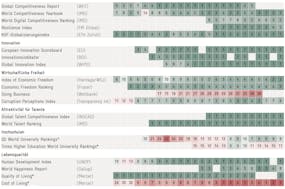The preservation of a fluid labor market free of excessive restraints, in particular regarding recruitment processes and wage setting, is one of the reasons to which Switzerland owes its prosperity. This approach has permitted the country to maintain a relatively low unemployment rate together with a high rate of professionals. Despite this achievement, we still witness numerous attempts to further regulate labor policies in Switzerland. These recommendations often stem from a good place but generally tend to miss their target and end up creating conflicts with the sought-out objective. Two examples: seniors’ labor market and the facilitated expansion of the scope of CLAs.
The Swiss population supports it’s liberal and flexible labor
Compared to an international benchmark, Switzerland’s labor market is not as heavily regulated as other countries, especially regarding the direct relations between employers and employees. Wages and work patterns can be set freely, and there are few constraints limiting recruitment and layoff procedures. In numerous branches, the rules of the labor market game are set by social partners (such as employee organizations or individual companies to unions or employee associations) and put on paper in CLAs. In principle, only the companies and employers that have explicitly adhered to a CLA are consequently bound by them.
This liberal and liberated attitude towards labor is very much rooted in the culture of the country and has benefitted from popular support for a long time. Nearly all federal referendums requesting supplementary labor regulations and restrictions have been widely discarded: 6 weeks paid vacation for all (2012), the 1:12 initiative (2013), and a federal minimum salary (2014). There was one exception; in 2013, the Minder initiative, which condemned disproportionate salaries, was accepted. It became the symbol of a Swiss voting population exasperated by the incomprehensible compensation policies for senior executives in some important companies based in the country.
France, Spain, Italy: A poor inspiration for labor regulations
While Switzerland continues to value fluidity in the workplace, certain countries in close proximity (in particular France, Spain, and Italy) amassed corporatist or state regulations for which the main objectives were to protect the workers from employer “exploitation”. This regulatory hypertrophy mainly manifested itself through rules prohibiting layoffs or imposing minimum wages. These countries clearly prioritized the prevention of possible abuse towards workers, rather than the development of a framework favoring the creation of job opportunities, entrepreneurship or the evolution and change of careers. The result of these policies is dramatic: with a rather troubling youth unemployment rate, France (close to 25%), Italy (close to 35%), and Spain (over 40%) have produced real social time bombs. A “lost generation” who cannot access the labor market (through permanent contracts), has been created; minimum wages cause their hiring to be too expensive, and the proscription of redundancies discourages companies and entrepreneurs from creating employment. The “insiders” (those already employed) are sturdily protected, at the expense of the “outsiders” (all those trying to access the labor market).
In spite of these disastrous foreign experiences, similar propositions to strengthen labor regulations are recurrently debated in Switzerland, as is the case with senior workers and accompanying measures.
Senior unemployment: Avoid going wrong when choosing solutions
Regarding the senior labor market (age 50 and above), Switzerland sustains a rather different position. The senior employment rate is one of the highest in Europe (good news: in their vast majority, Swiss companies are loyal and faithful to their elder employees). However, the proportion of long-term unemployed people over 50 years old is much higher than that of the younger generation (bad news: it is difficult for senior employees to re-enter the labor market once they have exited it). Therefore, the real challenge for Switzerland is to find solutions enabling senior workers to return to the labor market, such as additional training, eradication of negative cultural stereotypes towards workers over age 50, personalized and flexible conditions, etc. Nevertheless, some advocate for the creation of a framework prohibiting layoff of workers aged over 50 or formalizing more advantageous working conditions for senior workers (for example, additional holidays, higher wage rates, higher employer contributions). These propositions do not help decrease senior unemployment; worse, they accentuate the problem by rendering the recruitment of new senior collaborators less attractive for an employer. In other words, these measures would reinforce the protection of the older insiders (those already in employment and that are globally well taken care of in Switzerland). But they would also weaken the opportunities for outsiders over 50 years old who are looking for a job. With equal qualifications, they cost more or offer less flexibility. Yet, they form the most socially fragile category (see Avenir Suisse, Jérôme Cosandey, “Employement for the elderly in ist infancy”, 2015).
Accompanying measures and free movement of persons: Avoiding regulatory overbidding
Another example: in order to obtain a political majority in favor of the free movement of persons within the EU, Switzerland has, since 2004, agreed on a series of accompanying measures (AMs) that have been constantly reinforced since then. The AMs mainly enable a facilitated mandatory broadening of Collective Labor Agreements (CLAs), including minimal wages, to entire sectors, even for employers who explicitly did not want to submit to the CLA. The original intention of the AMs was to avoid any negative repercussions on the wages of workers residing in Switzerland that may have been caused by the entry of new workers coming in from the EU who were hypothetically less well paid. However, after more than a decade since the inclusion of the free movement of persons, there has been no global deterioration of wages in Switzerland; in fact, the result has been quite the contrary. The global level of salaries has regularly increased (although not in the same proportion for all employee categories). Nevertheless, the AMs have constantly been broadened and reinforced (see Avenir Suisse, Tobias Schlegel, “Free movement of persons and accompanying measures—Less constriction of the labor market”, May 2017).
Based on the AMs, employers’ organizations and trade unions have obtained various mandatory developments in the CLAs while enforcing regulations (in particular regarding wages) to an entire economic sector (including for companies that did not wish to adhere to a CLA). This underlying labor cartelization becomes a form of substitution for state regulation, as opposed to the traditional and efficient liberal and flexible labor market in Switzerland. Moreover, it tends to further increase the average cost of work, which is already quite expensive in Switzerland. This creates additional incentives for local companies to make even greater use of automation, relocation, or foreign outsourcing, all detrimental phenomena that impact the volume of jobs in Switzerland.
In terms of labor, the road to a regulatory inferno really is paved with good intentions, and the “solutions” chosen often prove to be counterproductive to the sought objective.





